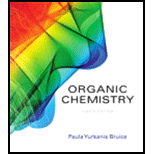
Concept explainers
(a)
Interpretation:
The electrophile reactant and nucleophile reactant in the given reaction has to be indicated.
Concept introduction:
Nucleophiles are the electron rich species and it can share at least a pair of electron. Nucleophiles have negative charge.
Electrophiles are electron deficient species; they look for a pair of electrons. An electrophile has a positive charge, a partial positive charge or an incomplete octet that can accept electron.
(b)
Interpretation:
The electrophile reactant and nucleophile reactant in the given reaction has to be indicated.
Concept introduction:
Nucleophiles are the electron rich species and it can share at least a pair of electron. Nucleophiles have negative charge.
Electrophiles are electron deficient species; they look for a pair of electrons. An electrophile has a positive charge, a partial positive charge or an incomplete octet that can accept electron.
(c)
Interpretation:
The electrophile reactant and nucleophile reactant in the given reaction has to be indicated.
Concept introduction:
Nucleophiles are the electron rich species and it can share at least a pair of electron. Nucleophiles have negative charge.
Electrophiles are electron deficient species; they look for a pair of electrons. An electrophile has a positive charge, a partial positive charge or an incomplete octet that can accept electron.
(d)
Interpretation:
The electrophile reactant and nucleophile reactant in the given reaction has to be indicated.
Concept introduction:
Nucleophiles are the electron rich species and it can share at least a pair of electron. Nucleophiles have negative charge.
Electrophiles are electron deficient species; they look for a pair of electrons. An electrophile has a positive charge, a partial positive charge or an incomplete octet that can accept electron.
Want to see the full answer?
Check out a sample textbook solution
Chapter 5 Solutions
Organic Chemistry; Organic Chemistry Study Guide A Format: Kit/package/shrinkwrap
- draw the nucleophile and electrophile precursor for the structures below Azo Dye N `N OH grat Nucleophile Electrophilearrow_forwardPropose an intermolecular interaction that explains how protic solvents affect nucleophiles? Draw an example of this.arrow_forwardDraw the product for the attached reactions.arrow_forward
- In polar process of the reactions Bond formation is unsymmetrical Bond breaking is homolytic O Arrowheads with a "half" head O electrons move from electrophile to nucleophilearrow_forwardSpecies that accepts e- pairs CHOICES: anion nucleophile electrophile carbocationarrow_forwardDraw the products of each Lewis acid-base reaction. Label the electrophile and nucleophile. CH3 CH3 + H2SO4 CH3 CH3 + H20arrow_forward
- An S 2 reaction takes place where a nucleophile displaces a leaving group at a stereocentre. If the stereocentre in the reactant is (R), which of the following is true? A) The stereocentre in the product will become (S) B) The stereocentre in the product will stay (R) C) Not enough information is given to answer the question 14arrow_forwardWhen the molecule reacting with the electrophile is a strong nucleophile and a strong base, the substitution reaction is favoured when There is the least amount of crowding (steric hindrance) around the alpha carbon There is the most amount of crowding (steric hindrance) around the alpha carbon The leaving group is a strong basearrow_forwardElectrophilic aromatic substitution reactions require activating the nucleophile. True or Falsearrow_forward
- Identify the nucleophile and leaving group and draw the products of attached substitution reaction.arrow_forwardLabel the nucleophile and electrophile. For the electrophiles mark the place for nucleophilic attack.arrow_forwardWrite down the molecular formula of the handdrawn image of the attached molecule, explaining how many carbon etc to get the molecular formula and hand-draw a Lewis dot and cross diagram of molecule. labelling the atom that is the most likely to act as an electrophile, and the atom that is most likely to act as a nucleophile in a condensation reaction. Iarrow_forward
 Organic Chemistry: A Guided InquiryChemistryISBN:9780618974122Author:Andrei StraumanisPublisher:Cengage Learning
Organic Chemistry: A Guided InquiryChemistryISBN:9780618974122Author:Andrei StraumanisPublisher:Cengage Learning
 EBK A SMALL SCALE APPROACH TO ORGANIC LChemistryISBN:9781305446021Author:LampmanPublisher:CENGAGE LEARNING - CONSIGNMENT
EBK A SMALL SCALE APPROACH TO ORGANIC LChemistryISBN:9781305446021Author:LampmanPublisher:CENGAGE LEARNING - CONSIGNMENT Chemistry & Chemical ReactivityChemistryISBN:9781133949640Author:John C. Kotz, Paul M. Treichel, John Townsend, David TreichelPublisher:Cengage Learning
Chemistry & Chemical ReactivityChemistryISBN:9781133949640Author:John C. Kotz, Paul M. Treichel, John Townsend, David TreichelPublisher:Cengage Learning



